The Women’s Championship has helped bring through players such as England Internationals Beth Mead, Ebony Salmon and Millie Bright over the years.
In this data analysis, we have used data and statistics to examine some of the leading young midfielders in the Women’s Championship this season. With us roughly halfway through the season heading into the winter break, we will look at ball progression, chance creation and defensive actions in order to paint a more complete picture of the leading young midfielders in the Women’s Championship for 2023/24.
Criteria
In order to qualify for this analysis piece, first of all, you need to be 25 years of age or younger. Second, you have to have played at least 450 minutes in the Women’s Championship this season, which is roughly half the minutes available to all the teams this season, with some teams having played 10 games while others having played 12. This left us with 26 players for us to analyse and compare.
Ball progression
One of the most essential aspects of midfield play is the ability to help the team progress the ball up the field. In this section, we take a look at some of the leaders within our data set when it comes to ball progression.
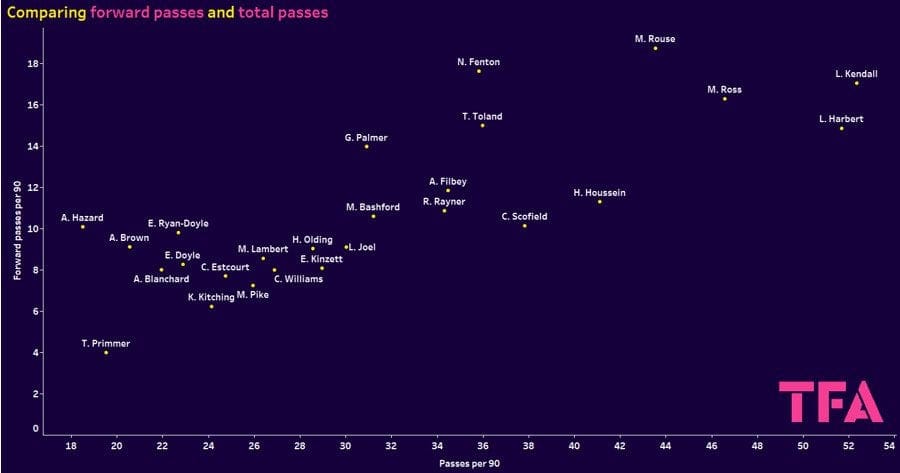
The first graph we are going to look at is the total number of passes per 90 against the total number of forward passes per 90. This produces a graph as seen above. The first two names that stand out are Laila Harbert, the 16-year-old midfielder playing for Watford on a dual registration with Arsenal. Another name that stands out is 19-year-old Lucia Kendall. Both of these players have a high number of passes per 90, with Kendall averaging 52.3 and Harbert averaging 51.7. This suggests that these two players are integral pieces to their sides in possession; they also have a high number of these passes being played forwards. With Kendall averaging 17.1 and Harbert averaging 14.9.
The next exciting thing that stands out to me is the outliers such as Natasha Fenton, who, although she averages fewer passes per 90 at 35.8, a higher proportion of them are played forwards at 17.6. Nearly half of her passes are being played forward, suggesting a more progressive ability on the ball. Another player with a similar proportion of forward passes is Fenton’s midfield partner at Sunderland, Mollie Rouse, who averages 43.5 passes per 90, and 18.7 of these are forwards; this leads our dataset.
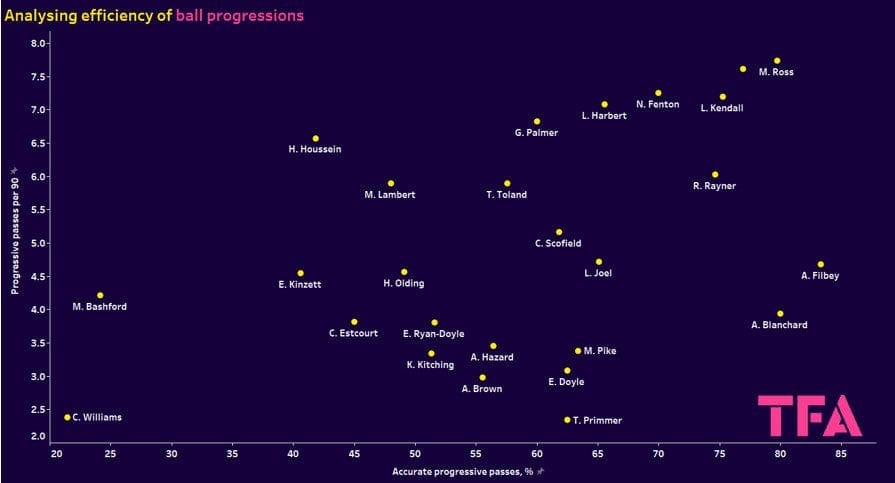
Having looked at the direction, these players are distributing the ball in possession. Now, we are going to look at how successfully these players are at progressing the ball. The names that stand out here is Mia Ross; playing for Charlton this season, Ross has averaged 7.73 progressive passes per 90, which leads our data set; however, the most notable aspect of this is the rate at which she is completing this at a staggering 79.7% which given she is completing the most goes to show her quality in this area. The other players that lead in this area are Rouse (7.61 at 76.9%), Kendall (7.19 at 75.3%) and Fenton (7.25 at 70%). A new player who has cropped up is Rebecca Rayner, who, although she attempts fewer passes than the aforementioned four, at 6.02, still completes them at a high rate of 74.6%.
Having taken a look at some of the most progressive players in terms of passing, let’s now take a look at the most progressive in terms of progressing with the ball at their feet, i.e. in dribbling.
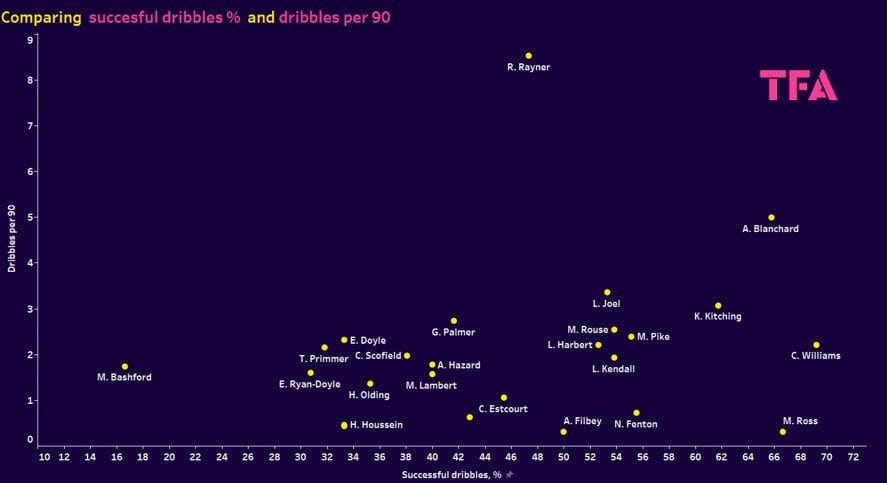
The first dataset we will look at is how our data set has fared in dribbling. To do this, we compared the dribbling success rate with the number of dribbles attempted per 90. The name that instantly stands out is Rayner, averaging 8.53 dribbles attempted per 90, 3.54 higher than the next best, Annabel Blanchard, at 4.99. This, however, can be explained in part due to her time spent on the wing, where the job requirements are slightly different, and she is given more opportunities to dribble at opponents.
Having addressed that outlier, let’s look at other notable leaders in this category. We have already mentioned Crystal Palace midfielder Blanchard, but although she’s attempting fewer dribbles, her success rate is considerably higher at 65.8% compared to Rayner, who is at a rate of 47.4%. So, you could argue that Blanchard is less wasteful in these situations than Rayner. The other two names that stand out are Manchester United youth product Chloe Williams, now of Blackburn, with the highest success rate at 69.2% on 2.21 dribbles per 90. Katie Kitching also has a high success rate of 61.8% on 3.07 dribble attempts.
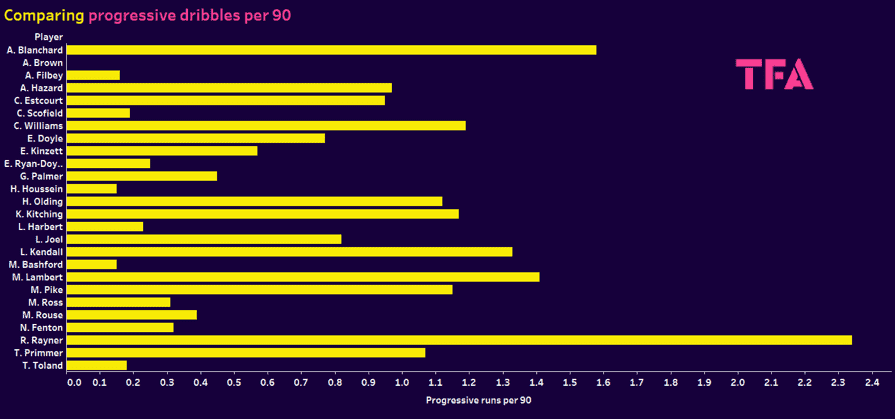
Having looked at dribbling, we see a similar story of names when we look at progressive dribbles per 90, with Rayner (2.34) and Blanchard (1.58) again leading our data set. However, some interesting new names appear, with Mollie Lambert of Durham having the third most progressive dribbles at 1.41. Additionally, Kendall is high in this category, averaging 1.33 progressive runs per 90.
Chance Creation
Having compared how the midfielders appear in terms of ball progression. We now take a look at how they compare in terms of chance creation.
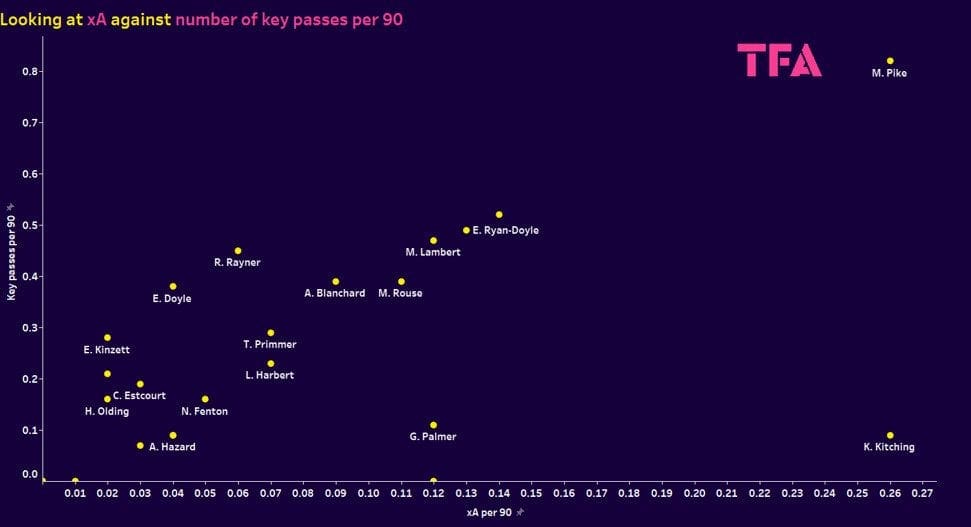
The first graph to look at compares xA per 90, and the number of key passes per 90. This is an essential comparison as it gives an idea of the quality of chances created by the players. A high number of key passes and low xA suggest less dangerous chances. While the opposite is true if the number of key passes is low, but xA is high.
Some interesting things to note are that the data set has instantly become considerably smaller, with several players registering both no key passes and expected assists of zero. Then comes the two names that stand out from the graph: Molly Pike from Southampton and Kitching from Sunderland. It’s important to note that these two would generally be considered more advanced players playing more as number tens. Nonetheless, Pike averages 0.82 key passes per 90 and an xA of 0.26. She leads the data set for key passes by a staggering 0.3 ahead of teammate Kendall. The other name that stands out is Kitching, and although she is averaging only 0.09 key passes per 90, her xA is at 0.26, which suggests that she has an alternative source for chance creation.
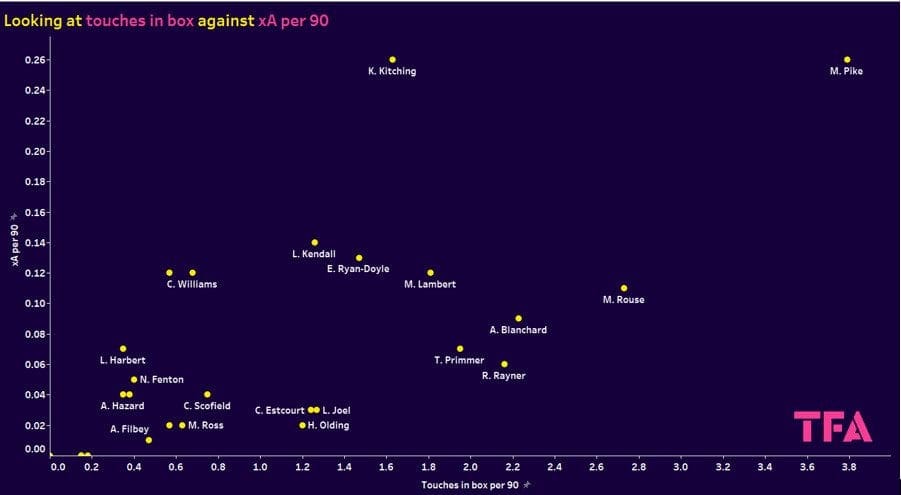
Having looked at how several key passes correlate with xA created. It’s also interesting to look at how the number of touches in the box can relate to xA being created. The likelihood is that the more touches in the box, the more chances you can create unless you are being inefficient.
Again, we see Pike leads the way with 3.79 touches per game, which helps us understand why she leads the way in terms of xA. However, the most interesting one is Kitching, who only averages 1.63 touches in the box yet can create the same amount of xA, suggesting she can create from deeper or more efficiently inside the box.
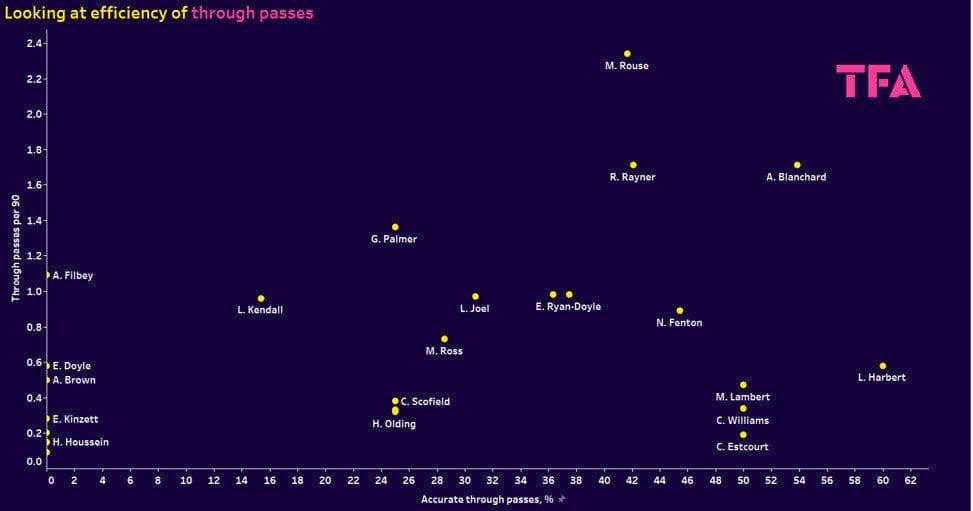
A further key aspect of chance creation for midfielders is the ability to play well-weighted through balls that put teammates through into space. In this graph, we take a look at how our players compare when we look at the efficiency of through balls.
Rouse leads the way in the number of through passes per 90 with 2.34. She is followed by Rayner and Blanchard, who average 1.71 per 90. Again, it’s interesting to note how Blanchard is more efficient than Rayner, though her success rate is 53.9% compared to Rayner’s 42.11%. Another notable player here is Harbert, who, although she averages 0.58 through passes, has the highest success rate of 60%.
Defensive Attributes
Having looked at both ball progressions and chance creation, a further vital characteristic in a successful midfielder is the ability to win the ball back and prevent opposition attacks from developing. Here, we will outline some key areas of interest on the defensive side of the ball.
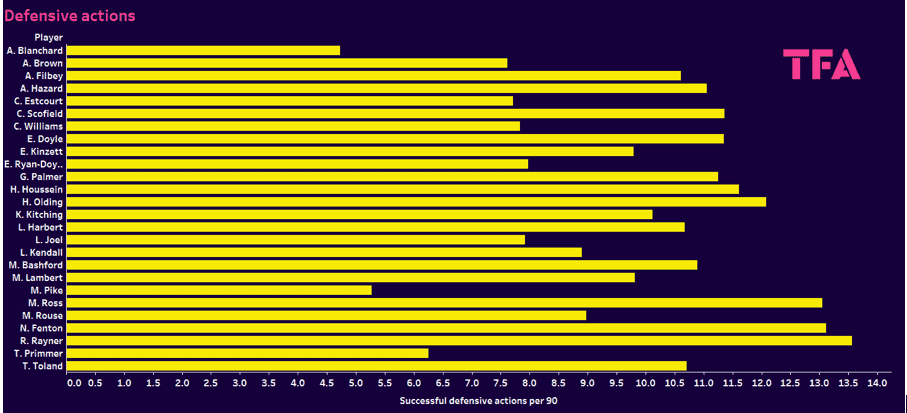
The first key idea we wanted to highlight was the number of successful defensive actions per 90, combining tackles and interceptions. The names that lead this aspect of the game are Rayner, with 13.6, which is interesting, considering she has occupied a more advanced role for the Sheffield side this season. Other players to lead this area are Ross with 13.05 and Fenton with 13.12. These two players have played as deeper midfielders this season, which would potentially give a reason for these high figures.
Generally, players who have played in more advanced midfield roles, such as Pike, Blanchard, and Tia Primmer at Reading, have completed fewer defensive actions. This makes Rayner’s high number of successful actions all the more impressive.
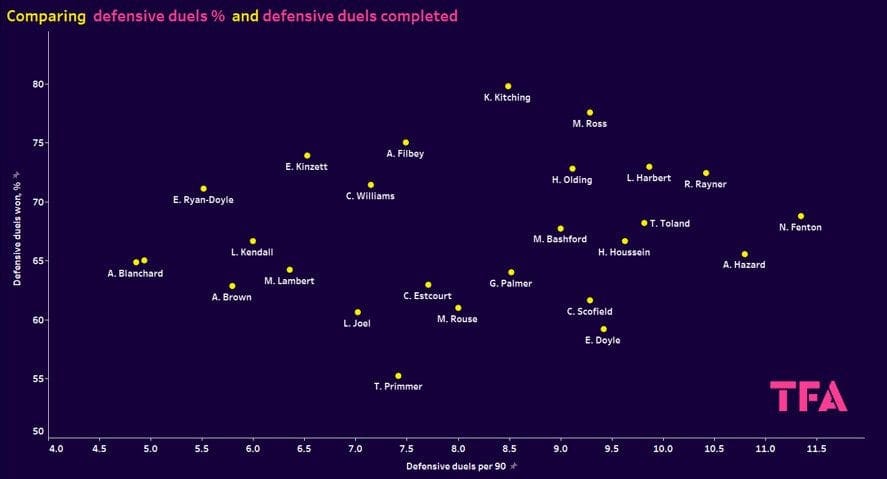
The above diagram, although provides an excellent avenue to compare defensive actions, doesn’t provide context as to how the teams play and are able to show that teams asked to sit back and play a low block are more likely to complete a higher number of defensive actions. So, to provide a better context as to how successfully players can defend within these midfield duels, we look at the success rate of defensive duels against the number of defensive duels per 90.
This graph shows a widespread amount of data. The two names that stand out again are Kitching and Ross, with a success rate of 79.8% and 77.5%, respectively. A name we haven’t mentioned up until now is former Tottenham player Anna Filbey, who is currently at Crystal Palace. She is completing 7.49 defensive duels at a rate of 75%.
Conclusion
Hopefully, this has provided you with some context as to some younger midfield players who are coming through in the Women’s Championship and can potentially push on and become useful WSL players over the next few years.
A few names have appeared consistently throughout this piece: Natasha Fenton, Katie Kitching of Sunderland, Molly Pike, and Lucia Kendall of Southampton. It’s no wonder these two sides are currently mounting significant promotion charges.
A further player that particularly stood out as someone to look out for was sixteen-year-old Laila Harbert, who was on a dual contract with Arsenal. She stands out in a Watford side that has struggled following promotion last season, sitting bottom of the league. She could be an exciting player for Jonas Eidevall‘s side over the next few years.
The Women’s Championship is a hotbed of talent, and it will be interesting to see how these young midfielders develop in the future.






Comments